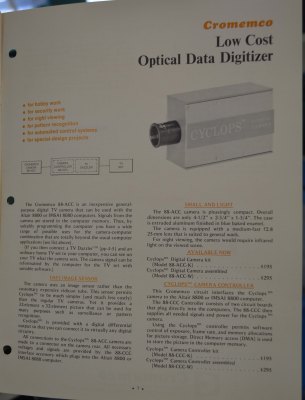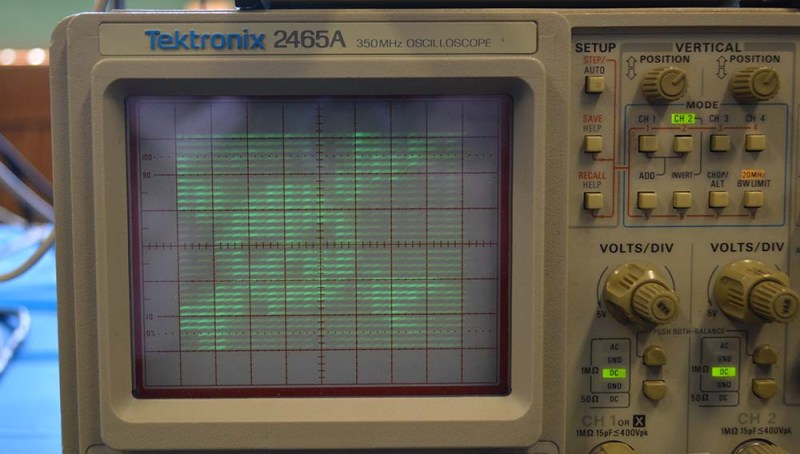While the official history of the digital camera begins with a Kodak engineer tinkering around with digital electronics in 1975, the first digital camera was actually built a few months prior. At the Vintage Computer Festival East, [William Sudbrink] rebuilt the first digital camera. It’s wasn’t particularly hard, either: it was a project on the cover of Popular Electronics in February, 1975.

[William]’s exhibit, Cromemco Accessories: Cyclops & Dazzler is a demonstration of the greatest graphics cards you could buy for S-100 systems and a very rare, very weird solid-state TV camera. Introduced in the February, 1975 issue of Popular Electronics, the Cyclops was the first digital camera. This wasn’t a device that used a CCD or a normal image sensor. The image sensor in the Cyclops was a 1 kilobit DRAM from MOS, producing a digital image thirty-two pixels square.
The full description, schematic, circuit layout, and theory of operation are laid out in the Popular Electronics article; all [William] had to do was etch a PCB and source the components. The key part – a one kilobit MOS DRAM in a metal can package, carefully decapsulated – had a date code of 1976, but that is the newest component in the rebuild of this classic circuit.
To turn this DRAM into digital camera, the circuit sweeps across the rows and columns of the DRAM array, turning the charge of each cell into an analog output. This isn’t a black or white camera; there’s gray in there, or green if you connect it to an oscilloscope.
This project in Popular Electronics would be manufactured by Cromemco in late 1975 and was released as their first product in January, 1976. The Cromemco was marketed as a digital camera, designed to interface with the MITS Altair 8800 computer, allowing anyone to save digital images to disk. This was the first digital camera invented, and the first digital camera sold to consumers. It’s an amazing piece of history, and very happy [William] was able to piece this together and bring it out to the Vintage Computer Festival this weekend.


















Was it really “the first”? Where did the concept of using the dynamic RAM as a sensor come from?
I remember something, maybe in Popular Science, about this sort of thing, but can’t remember a date. I do remember a photo of the results, very blockish. So when I saw Westworld, it would have been on TV, there was the same pixilated image, when we see the Gunfighter’s viewpoint.
Since I remember the Cyclops in Popular Electronics, I think other things were going on, though the Cyclops had to be the first for the hobbyist or sort-of consumer.
I think it was in the eighties, Steve Ciarcia had a digital camera for a computer, I specifically remember the Apple II, which used a commercial sensor, but that sensor was a glorified dynamic RAM, so some company pursued it. I thought dynamic ram was one of the ways to make sensors for cameras.
I seem to recall that the Cyclops was just going to be a project, but after the Altair 8800 hit in January of 1975, Popular Electronics ask Garland and Melon to modify the project so it would interface with the computer.
Michael
If you don’t think it is the first, then feel free to do the due diligence and come back with something that’s not just apathetic whimpering and gesturing.
Some of the first spy sattelites in the 60’s and 70’s that did not try and parachute film back home. they took the image data and digitized it to send it over encrypted RF digital back home.
Ha Ha. No.
That was firstly, not digitized. It was a traditional television signal, with analog video levels and sync. Second, encrypted? On a satellite? In the 70’s? You do realize they couldn’t even fit a computer in there, much less any crypto hardware? They were lucky if they had any kind of analog image transmission at all.
There’s a well known story about overoptimistic predictions, involving Marvin Minsky in 1966, when he asked some students to develop a program over the summer that could recognize objects shown to a large PDP computer through a camera, thinking they’d have it figured out by the end of the summer. The rest is history.
I first learned about this in the book “HACKERS: Heroes of the computer revolution” which discussed the entire line of events leading up to that summer, including how they got the computer to control and digitize video from a traditional camera (an even the previous projects, like getting a small robot with a scoop to retrieve objects thrown into the cameras field of view). If that’s included in ‘digital camera’ then this is an even earlier example, and there are likely many others that could be even earlier regarding other projects.
https://en.wikipedia.org/wiki/Charge-coupled_device
Bell labs, 1969, for a CCD imaging device.
Talking about glorified D-Ram how about this project from the book “Electronic Projects for your Commodore 64 and 128” by John Iovive. (1989) (Chapter 9. pg 98-138) https://archive.org/details/Electronic_Projects_for_your_Commodore_64_and_128/page/n105/mode/2up
Digital Camera: Build your own by taking the cover off a IM-16 D-Ram chip. 128×64 resolution.
The write up goes into detail about the theory w/schematics, several sample pics, S/W for the C64 & 128 and the history of this kind of project.
I had this book as a kid and while I never did this project (didn’t have the chip to play with) this project never left my mind. The fact a C=128 could ‘digitize’ an image like the Amiga . I do remember trying to build the sound digitizer but I could never get it to work
Scott P
Did I miss the link to the full article in PE? Anyway, I did find the entire issue of February 1975 Popular Electronics on imsai.net.
I can remember scraping the tops off DRAM chips to play with this effect around that time, probably after reading that article.
If there were an edit function, I would have added [PDF] beside that link…
If there were an upvote mechanism, I’d give you a +1 :)
Wow! Child hood flash backs.
I remember when I was a kid buying an introductory book on robotics, in the early 80s. It described this vision method. They used a memory chip in a CERDIP package – it had solder on top that was easy to remove. However, no local electonics retailers had heard of this, and it was pre-internet, so all I could try was an epoxy version, and take the cover off with a bench grinder.
Of course, that failed miserably.
I remember the same experiment – of course also with the same outcome. But as a teenager I did not like to work with hot concentrated acid or would have tried to get it.
The image reminds me of when I first made a digital raster display for an oscilloscope (CRO). Bits were expensive then so I could only afford 4 for horizontal and 4 for vertical. This project has a whaopping 5 bits vertical and it looks like even more for horizontal. :)
Besides watching my friends trying to find you Brian, and studying the booth next to his who described a home built S100 system, I studied his. Very interesting idea.
Well not exactly, how about this from 18 years earlier?http://www.nist.gov/public_affairs/techbeat/tb2007_0524.htm#image
More info here, see image and caption, https://en.wikipedia.org/wiki/Image_scanner#Drum
That’s a drum scanner. Not the same thing.
Saw this mentioned on the cctalk mailing list the other day, but the builder didn’t give any historical background to his project, only that he’d built it and had some test photos, which left me scratching my head going ‘so what?’.. Thanks to this HaD article, now I know it was a build from an original 1970’s magazine, and I am duly impressed!
First digital camera I ever encountered was a Logitech FotoMan.. IIRC it was $600 or so, 376×240 grayscale and could hold I think 32 pictures on its internal (volatile) memory, and PC attachment was via a serial cable.
If anyone comes across this page and is interested in more information, I have made a website with more photos and descriptions:
http://wsudbrink.dyndns.org:8080/cyclops/index.html
There are indications that the Cyclops was actually marketed as well as being in a magazine with instructions on how to build. Does anyone know for sure whether the Cyclops was marketed, the MSRP, and how about how many were sold. If some were marketed, are any available?
https://web.archive.org/web/20141006100202/http://startup.nmnaturalhistory.org/gallery/notesViewer.php?ii=76_1&p=8